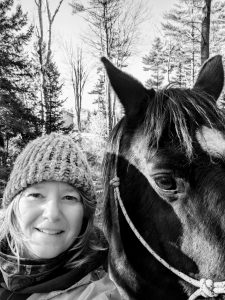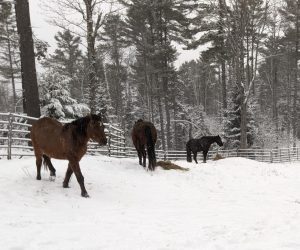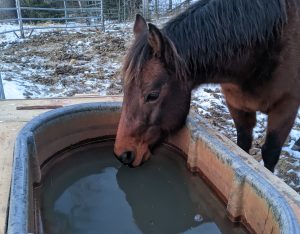Editor’s Note: Julie Kenney is an avid horsewoman, former Best Horse Practices Summit board member, and runs Blackberry Farm in Harpswell, Maine. She shares this reflection on moving forward, resisting trending calls around the New Year.
 Julie writes:
Julie writes:
In Maine today, even here at the coast where temperatures tend to stay more moderate due to having the ocean at our doorstep, we are experiencing below zero wind chills. In preparation for the frigid cold, there was a post on social media by a local police department reminding us that it was Maine law to bring animals inside.
From the Facebook page of the police department in Bath:
“Animal Control Note: Please bring ALL Cats and Dogs inside the house tonight. Temps will turn brutal with wind chills. ALL animals including Cows, Horses, and other livestock must have the ability to get inside a shelter that protects them from the prevailing winds. This is the State law. Some livestock breeds thrive in colder temperatures i.e. Highlander Cows, Draft horses, etc. However, a shelter MUST be accessible regardless. If you suspect animal neglect please contact your local Police Department and Animal Control Officer. Stay safe.”
 After reading the post, I had several online conversations with another local horse owner about whether draft horses, per se, were better able to thrive in colder temperatures. It was an odd statement and really showed a lack of equine education. Draft horses are still horses and their breeding does not predilect them to being better at handling cold than others. I conferred with my friend, Dr. Sheree King, who is a former Professor of Equine Science at Southern Illinois University Carbondale. She concurred that “If they have a full winter coat and access to a windbreak they are not stressed by subzero temperatures. They need access to hay and hopefully warmed water (40 degrees or so). If you watch those horses given a choice with a run-in shelter, most will stay out unless there is a wind.”
After reading the post, I had several online conversations with another local horse owner about whether draft horses, per se, were better able to thrive in colder temperatures. It was an odd statement and really showed a lack of equine education. Draft horses are still horses and their breeding does not predilect them to being better at handling cold than others. I conferred with my friend, Dr. Sheree King, who is a former Professor of Equine Science at Southern Illinois University Carbondale. She concurred that “If they have a full winter coat and access to a windbreak they are not stressed by subzero temperatures. They need access to hay and hopefully warmed water (40 degrees or so). If you watch those horses given a choice with a run-in shelter, most will stay out unless there is a wind.”
 It makes no difference between draft breeds, Shetland ponies, Arabians, or any other equine breed. Each can handle cold the same if they are allowed to acclimate to a cold-weather climate. Ship a draft breed up from Florida to Maine in the middle winter and they will likely have a harder time staying warm than their herd mate who’s been here all year. Horses have the ability to regulate their own temperature through piloerection, which is the raising and lowering of their coat using hair-erector muscles.
It makes no difference between draft breeds, Shetland ponies, Arabians, or any other equine breed. Each can handle cold the same if they are allowed to acclimate to a cold-weather climate. Ship a draft breed up from Florida to Maine in the middle winter and they will likely have a harder time staying warm than their herd mate who’s been here all year. Horses have the ability to regulate their own temperature through piloerection, which is the raising and lowering of their coat using hair-erector muscles.
On this cold winter day, my thick-haired horses are enjoying basking in the sun in single-digit temps with their herd mates. Their drowsy, contented bodies, minds, and souls are in tune with each other, absorbing what warmth they can from the low-angled sun. Every so often they amble over to the heated water tub for a drink and snack on the extra hay I put out for them.